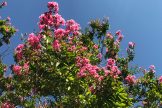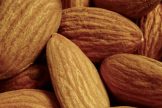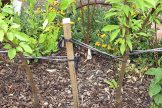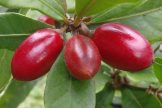
 Important note about plant availability. Important note about plant availability.There are hundreds of factsheets on our website provided for your information. Not all plants will be available at all times throughout the year. To confirm availability please call (03) 8850 3030 and ask for the nursery. |
Jujube (Chinese Date – Hong Zao)
Please note, we cannot fill our local demand and do not post plants. We only deliver to nearby suburbs in Melbourne.
In the past it has been hard to get jujube trees in the past in Australia, but now that they are being grown at a small number of propagation nurseries here, they are starting to become more available.
Jujubes are not only great to eat, but they grow very well in our climate and conditions. Be aware that as a rare plant they are more expensive than your average fruit tree, but you will find them worth the extra cost.
The fresh fruit is often likened to apples (to which they are unrelated), with a crisp flesh and sweet flavour. Plants grow into small to medium sized trees up to 10 metres in height. They tolerate drought and cold to -10 degrees Celcius and will produce optimally with watering and fertilising. Jujubes are deciduous and will produce fruit in high quantities soon after planting. They also suffer minimal insect pests and diseases, but you will still need to be on the lookout for possums and birds.
Originating in China, and cultivated there for 4000 years, this small fruiting tree has been exported widely around the world. The Jujube is an elegant drooping small deciduous tree (7-10m) with shiny bright green leaves suitable for almost any environment in Australia. The fruit can be eaten fresh (sweet pleasant flavour, crisp texture) or dried (sweet, like a date) and is highly regarded for its flavour as well as for its nutritional value. High in various vitamins as well as in antioxidents, it is widely used in Chinese medicine.
Growing
This is the easy part – the hard part is getting a tree. Jujubes tolerate just about anything. They will tolerate extreme heat and cold, as well as saline conditions. They do need sun, and prefer well drained soil, otherwise are undemanding and can perform well with very little additional fertilising. Currently jujubes are grown on a rootstock that suckers, so if you’re going to get one please remember to remove suckers if they appear and to plant it a bit deeper in the ground. Otherwise, grow it in a restricted growing space such as an enclosed garden bed or a large pot.
Most cultivars are self pollinating. You can prune if you want to keep the tree to a more accessible size, and winter pruning (when all the leaves have dropped) will improve health and vigour. No spraying is necessary as no serious pests or diseases have appeared in Australia.
The fruit needs to be removed from the tree when ripe, as it will not ripen further after being picked. Fruit can be left to dry on the tree and will store indefinitely. This is a real bonus as it can be dried without the use of sulphur as a preservative.
For available cultivars, please call the nursery.
Looking after your brand new Jujube

They were potted up in August this year from a washed bare root plant. The new roots are very young, very fine and easily damaged. I recommend you keep the plant/s in the pot until January to allow the roots to develop before you plant it. Each pot has had enough slow release fertiliser added to it to feed the plant for the next three months in the pot.

Keep the potting mix just damp, not sodden and not dry. Jujubes like a sunny location.
Plant your jujube into a soil mixed with compost and manure. Half soil, half compost/manure mix. BEWARE: Rabbits love to eat every bit of this plant. If you have rabbits you will need to fence/protect it until it is too tall for the rabbits to reach the leaves.
The jujubes are grafted onto very vigorous root stock, remove any growth that may arise from below the graft. You may see it emerging from the soil – remove that also. You want only the grafted material to grow and do not want the plant putting energy into the rootstock material.

Jujubes are what we call precocious fruiters. This means it fruits very early in life. It will try to fruit this year. I recommend you allow a couple of fruit to grow, just for fun, but remove the rest and allow the tree to focus all its energy into root and stem growth. It can fruit all it wants the following season. Fruit comes on slender twiggy branchlets which arise from nodes (cones) on the main branches. Every winter both leaves and branchlets fall off and you are left with the main structural branches, dotted with nodes.
This is a deciduous plant – it loses its leaves in autumn and is bare all winter. It is NOT dead, this is normal. It will leaf up again each spring – be patient – it is one of the later leafing plants – leaves come in October.





